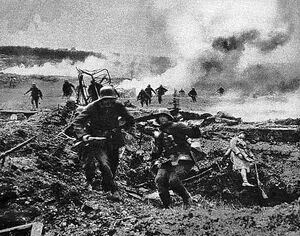| ||||||||||||||||||||||||||||||||
The Gemeinswehr, the military of Niflungland, constitutes in itself another branch of government, responsible for law enforcement and answerable to the Vísir alone as Supreme Commander of Niflungland. The organisation is directly descent from the army gathered under Sigurð Angatýrsson during the Civil War, the core of which was the paramilitary wing of the NRP known as the Stoßkommando (SK). The Royal Army of Johann II was officially disbanded at the end of the Civil War and fully replaced with the SK. The leadership structure of the SK was slightly different than of the Königliche Armee of Johann II in that all affairs were handled by the NRP (and later NAPN) Kommandeurtribunal (“Commanders' Tribunal”), made of nine commanders chosen by the head of the Armed Forces, the Führermarschall (Lead-Marshall) of the Commonwealth. The present Führermarschall is Duke Frederick Augustus of Saxony, who is also Minister of War.
The governing of the military is entirely interior; no civil court may hear a case involving an active soldier for any crimes, on- or off-duty. This is instead handled entirely by Courts Martial, who also oversee the trials of all prisoners-of-war and look, ultimately, to the Kommandeurtribunal for all military law. The Kommandeurtribunal plays essentially the role both of the Oberrat and the Hochgericht in that it is subordinate to law issued by the Decrees of the Vísir, but it both interprets those laws, and where interpretation becomes difficult, clarifies, and may indeed amend or alter laws at the discretion of the Vísir. Legally speaking, as a branch of the NARP, it is actually the Vísir of the Party, rather than the Vísir of the Commonwealth, (two offices which in theory are different) who has authority over the SK; however, since both offices and titles are held by the same individual, in practice it is the Vísir of the Commonwealth who has ultimate authority over the SK as Supreme Commander. If it were ever to happen, though, that the Vísir of the NAPN were a different individual than the Vísir of the Commonwealth of Niflungland, the military would be answerable to the former, though like all other branches of government, ultimately answerable to the latter.
Once made the legal national Armed Forces, the SK merged into a wider structure known as the Gemeinswehr, at which time only the former Königliche Armee became known as the SK; the Königliche Marine and Luftstreitkräfte became the Kriegsmarine (“War Navy”) and Fliegerkorps (Flying Corps). The fourth branch of the Armed Forces was the security branch of the SK, a paramilitary wing of the NRP since its very earliest days known as the Sicherheitstrennung (“Security Detachment”—ST). This party-operated security force became the official Polizeidienst of the Gemeinswehr, split into military-only and civil branches, the former of which retained the name ST, the latter of which became known simply as Polizei.
Mission & Service[]
The military in Niflungland's official mission as stated in the Constitution laid forth by Angatýrsson and the NAPN is "the defence and protection of Niflungan interests domestic, foreign, and on her frontiers." As such, the role of the Gemeinswehr is both defensive in nature, to protect Niflungland in case of invasion, and also offensive, to protect Niflungan interests, if need be, in aggressive war, in particular to protect the sovereignty of independent states who appeal to Niflungland for aid.
All men in Niflungland between the ages of twenty and thirty are required to enlist in some branch of the Gemeinswehr, though becoming part of the military rarely requires coercion. The two primary youth organisations of Niflungland, the Highland Scouts and the Bund jungen Heiden ("League of Young Pagans"), are permeated by a military aesthetic and structure, such that upon becoming too old for the organisations (at age 18), youth interested may enter a two-year training programme through the ORW's military wing known as the Ritter-Heranbilden Soldatendienst (RHSd) or "Soldiers' Service for Knight's in Training" (SSKiT, pr. "skit"). This intense physical and mental programme is administered by ORW-owned military academies throughout the country and over the course of two years trains students to perfect spoken and written German or English, depending on their origin, and physically trains them for military service. At the end of the two years, a graduate may choose a conventional military career, upon which he enters at an NCO rank, or to undergo further training and enter the élite Wotanssöhne, the military branch of the ORW.
During the period between twenty and thirty, a man will be called upon to undergo a year of basic training, after which he will be able to pursue a civilian career, but will be considered an Active Duty On Leave (ADOL) soldier of Niflungland. He may be called up at any point from his "on leave" status to fight should Niflungland be involved in war, but otherwise is simply registered as a soldier and must obtain special government permission to leave the country. Upon reaching his thirtieth year, any man has the option to become either a designated Career Soldier of Niflungland or end his military service and enter civilian life exclusively. Being a designated Career Soldier does not, however, mean exclusively military activities; for example, most professors at the Military Academies of Niflungland are in fact designated Career Soldiers. After the age of sixty, a soldier is asked if he wishes to retire from the military. If he is below the rank of colonel, he is required to respond "yes" to this, but if a colonel or above is given the option of serving until the end of his natural life.
Organisational Structure[]
The roughly 1.4 million men enlisted in the Gemeinswehr are not necessarily representative of the active military force at any given time. Because of conscription, all males of eligible age are listed as enlisted with the military, but are divided into two separate listings; "full active duty" soldiers are all those presently in training, on active duty, or listed as "career soldiers", while "active duty on leave", the bulk of the force, are all men not presently stationed or serving in military capacity in Niflungland. All men of serving age in Niflungland who are not enlisted and given legal excuse (the mentally retarded, clinically insane, and various other anti-socials) are listed in the military index as Ausgemustertsoldaten ("soldiers rejected for unfitness"). Those who are of serving age who are not registered with the military and are listed "in avoidance of service" are considered deserters, tried before court-martial, and are forced into service on undesirable duties or, in times of war, condemned as traitors and beheaded in the fashion of execution that has been in use in Niflunga since the sixteenth century: in the case of men ennobled and condemned as deserters, the Zweihänder, while in the case of commoners, a large double-headed axe is employed. All executioners employed are military personnel specifically assigned to the use of medieval weaponry, and specially trained in the art of killing with either the axe or the sword (different executioners are used for different executions).
Soldiers in the categories of active duty, either full or on leave, are divided into either Active or Reserve divisions, of which there are several in the Niflungan military. Reserve divisions comprise much of the force, constituting two-fifths of the armed force. The remaining peace-time Gemeinswehr constitutes of 874,800 men, of which, one-third is the ORW Wotanssöhne, the other 583,200 men are divided into the Stoßkommando, Kriegsmarine, and Fliegerkorps. The SK is the bulk of the force, with some 385,000 men; at the head of the order of battle of the peace-time SK are the First, Second, and Third Armees, comprised of seven Korps of 45,000 men each, and the Fourth Armee, comprised of two Korps of 34,500 men each.
The Wotanssöhne is structured slightly differently. The 291,600 men under the Ordensmarschall of the ORW are divided into nine Kriegerkreise, which serve as counterparts to the SK Korps. These "Warrior-rings" are divided into Wikingbänder ("Viking Bands"), the counterparts to the various Divisionen of the SK. The subsequent structuring then follows Legion for Brigade, Brigadelager for Bataillon("battalion"), Zenturie for Kompanie("company"), Kohorte for Zug("platoon"), Band for Feuerbrigade("Fireteam"/"Squad"), and Krieger for Soldat("soldier"/"private"). Each of the Kriegerkreise are named for one of the Nine Worlds of the Sacred Cosmology: Kriegergkreise Mittigart, Kriegerkreise Aesgart, Kriegerkreise Wanaheim, Kriegerkreise Jötunheim, Kriegerkreise Albenheim, Kriegerkreise Hel, Kriegerkreise Nithawellir, Kriegerkreise Muspell, and Kriegerkreise Nebelheim.
The other 198,200 men in the active military are the Kriegsmarine and the Fliegerkorps. The Fliegerkorps, consisting of 30,000 men, is structured after the SK, following the same ranking system and largely subordinate to the SK (thus the korps in the name). The sole difference is that the smallest subdivision of men are divided according to equipment, not unlike Panzer Divisions in the SK. In fact, all commanders above the rank of Generalleutnant ("Major General") in the Fliegerkorps are generals from the SK who have shown especial interest in the new flying machines.
The Kriegsmarine follows a similar rank structure to the SK but skipping certain ranks; the line of command is of course completely determined according to ships, such that the maximum crew of Niflungland's two leading battleships, the GWS König Jörg and GWS Völsung is 1280 men. The designation Besatzung ("crew") is roughly equivalent, therefore, to either a Battalion or a Company depending on the size of the ship. Men are only divided into smaller units if the ship they are on is large enough to require it. As a result, smaller vessels, such as riverboats and coastal patrol-boats, are often "captained" by ranks as low as Bootsmann or even Maat in some cases where the individual has distinguished himself. Battle cruisers are almost exclusively commanded by Kommodoren or Kapitäns zur See, unless they are the flag ship of a given task force, in which case they fall to the commander of that task force, either a Konteradmiral or Vizeadmiral.
Ranks[]
The ranks of the Armed forces are thus arrayed:
| Officers of the Gemeinswehr | ||||||||||
|---|---|---|---|---|---|---|---|---|---|---|
| Field Marshall (Generalfeldmarschall) GenFM/FM |
Lieutenant General (Generaloberst) GenOb/GL |
General (General der Inftantrie/Artillerie/etc.) Gen/G |
Major General (Generalleutnant) GenLt/GL |
Brigadier General (Generalmajor) GenM/GM |
Colonel (Oberst) Oberst/O | |||||
| Grand Admiral[1] (Großadmiral) GrAd/GD |
Admiral (Generaladmiral) GenAd/GA |
Vice Admiral (Admiral) Adm/A |
Rear Admiral (Vizeadmiral) VizAd/VA |
Rear Admiral (Konteradmiral) KonAd/KA |
No Equivalent | |||||

|

|

|

|

|

| |||||
[1] In the Kriegsmarine, the red base for the shoulder-board is replaced with a navy blue for Admirals and Commodores, and the black lining with gold for lower-ranking COs and NCOs. Enlisted men's shoulderboards are the same in all branches of service.
| Officers of the Gemeinswehr | ||||||||||
|---|---|---|---|---|---|---|---|---|---|---|
| Lieutenant Colonel (Oberstleutnant) Oberstlt/OTL |
Major (Major) Maj/M |
Staff Captain (Stabshauptmann) StHptm/SH |
Captain (Hauptmann) Hptm/H |
1st Lieutenant (Oberleutnant) OLt /OL |
2nd Lieutenant (Leutnant) Lt/L | |||||
| No Equivalent | Commodore (Kommodore) Komd/K |
Captain (Kapitän zur See ) KazS/KzS |
Lieutenant Commander (Korvettenkapitän ) KorK/KvK |
1st Lieutenant (Kapitänleutnant) KazS/KzS |
Lieutenant (Oberleutnant zur See) OLtzS/OLS | |||||

|

|

|

|

|

| |||||
| Non-Commissioned Officers of the Gemeinswehr | ||||||||||
|---|---|---|---|---|---|---|---|---|---|---|
| Sergeant Major (Oberstabsfeldwebel) OStFw/OSF |
First Sergeant (Stabsfeldwebel) StFw/SF |
Master Sergeant (Hauptfeldwebel) HptFw/HF |
Sergeant 1st Class (Oberfeldwebel) OFw/OF |
Sergeant (Feldwebel) Fw/F |
Staff Corporal (Stabsunteroffizier) StUffz/SU |
Corporal (Unteroffizier) Uffz/U | ||||
| Sergeant Major (Oberstabsbootsmann) OStBM/OSB |
No Equivalent | Master Sergeant (Hauptbootsmann) HptBM/HB |
Sergeant 1st Class (Bootsmannsmaat) BtsMM/BM |
Sergeant (Bootsmann) BtsM/B |
Staff Corporal (Obermaat) ObM/OM |
Sea Corporal (Maat) MT | ||||

|

|

|

|

|

|

| ||||
Equipment[]
Small Arms[]
| Type | Name | Ammunition | Weight | Feed | Action | RPM |
|---|---|---|---|---|---|---|
| Rifle (Infantrie) | Steyr-Mannlicher M1895 / Steyr-Mannlicher M1895L | 8x50mmR / 7.92x57mm Mauser | 3.83kg | 7-round clip / 5-round clip | Bolt-action | N/A (range ~1000m) |
| Rifle (Infantrie) | Mauser Kar 98a | 7.92x57mm Mauser / RM1913 rifle-grenade | 3.5kg / 4.09kg | 5-round clip / Single-shot | Bolt-action | N/A |
| Rifle (Kavallerie) | Winchester Kar95 "Yankee" | 7.62x54mmR | 4.1kg | 5-round internal | Lever-action | N/A |
| Shotgun (Infantrie) | Winchester M12 "Trenchgun" | 12ga | 3.74kg | 6-round tube +1 | Pump-action | 15 rpm slam-fire |
| Shotgun (Kavallerie) | Winchester M1901 | 12ga | 3.6kg | 5-round tube | Lever-action | N/A |
| Pistol | Luger P08 | 9x19mm PB | 871g | 8-round box, 32-round drum | Semi-auto | N/A |
| SMG | Bergmann MP18.1 | 9x19mm PB | 4.18kg | 32-round drum | Auto | ~500 rpm |
| Machinegun | "Spandau" MG08 | 7.92x57mm Mauser | 62kg | 250-round belt | Auto (air-cooled) | ~400 rpm (range ~3500m) |
Armour[]
| Type | Name | Armour | Weight | Primary Armament | Secondary Armament | Engine/Top Speed | Crew |
|---|---|---|---|---|---|---|---|
| Transport | Mk. IX Mannschaftstransportwagen | 10mm | 27t | 2x "Spandau" MGs | 16 loop-holes for soldiers | V-12 Liberty, 6.9kph | 4 (cap. 30 soldiers) |
| Medium Tank | Sturmpanzerwagen A7V | side 20 mm, front 50 mm | 30-33t | 57mm Nordenfelt cannon | 6x "Spandau" MGs | 2x Daimler 4c, 15kph | 16 |
| Medium Tank | Mk VIII Male (mod) | 16mm | 37t | 2x 57mm Hotchkiss cannon | 6x "Spandau" MGs | V-12 Liberty, 8.45kph | 12 |
| Heavy Tank | K-Wagen | 30mm | 120t | 4x 77mm PK cannon | 7x "Spandau" MGs | 2x V6 Daimler-Benz, 7.4kph | 27 |
| Light Tank | Leichter Kampfwagen | 14mm | 8.75t | 57mm Nordenfelt cannon | none | Daimer 4c, 18kph | 3 |
Artillery[]
| Type | Name | Cannon | Weight | Shell | Range |
|---|---|---|---|---|---|
| Heavy Artillery | 420mm Mörser L/16 | 6.723m | 140t | 42cm | 14,200m |
| Heavy Artillery | M-Gerät-14 L/12 | 5.88m | 39t | 42cm | 12,500m |
| Heavy Artillery | 210mm M16 Mörser | 2.67m | 6.68t | 21cm | 11,100m |
| Super-Heavy Artillery | "Donnarkanone" SK L/45 | 16.13m | 77.52t | 38cm | 47,500m |
| Super-Heavy Artillery | "Jomswiking" M 14/16 | 6.29m | 105t | 42cm | 14,600m |
| Field Artillery | FK 16 | 2.69m | 1,318kg | 7.7cm | 10,700m |
| Field Artillery | FH 98/09 | 1.625m | 1,145kg | 10.5cm | 7,000m |
| Field Artillery | FH 16 | 2.31m | 1,525kg | 10.5cm | 9,225m |
| Field Artillery | 135mm FK 09 | 4.8m | 6,730kg | 13.5cm | 15,100m |
| Field Artillery | sFH 13 "Standartehaubitze" | 2.54m | 2,250kg | 15cm | 8,600m |
| Field Artillery | 150mm K 16 | 6.02m | 10.8t | 15cm | 22,000m |
| Field Artillery | 170mm SK 16 | 6.9m | 61.5t | 17cm | 24,020m |
| Mountain Artillery | InfGe L/16 | 2.31m | 608kg | 7.62cm | 4,000m |
| Mountain Artillery | InfGe L/27 | 2.08m | 845kg | 7.7cm | 7,800m |
| Mountain Artillery | InfGe Skoda M15 | 1.155m | 613kg | 7.5cm | 8,250m |
| Mountain Artillery | InfGe Skoda M16 | 1.93m | 1,235kg | 10cm | 8,490m |
| Mortar | Minenwerfer M17 | N/A | 114kg | 9.15cm | 450m |
| Mortar | Luftminenwerfer M16 | N/A | 690kg | 20cm | 1,250m |
| Mortar | Minenwerfer Skoda M15 | N/A | 220kg | 14cm | 860m |
| Mortar | l.Minenwerfer Lanz | N/A | 114kg | 9.15cm | 450m |
| Mortar | m.Minenwerfer M13 | N/A | 483kg | 17cm | 1,600m |
Civil Involvement[]
| ST | |
|---|---|
| Sicherheitstrennung | |

| |
| The insignia of the ST | |

| |
| Review of the ST in 1914. | |
| Agency overview | |
| Formed | 1906 |
| Superseding agency | |
| Jurisdiction | |
| Headquarters | NRP Headquarters, Unter den Linden, Berlin (until 1920) |
| Employees | 850,000 (1919) |
| Ministers responsible | Johann Freiherr von Hochheim (1906-1914), Trennungkomtur-ST Sigurð Angatýrsson (1914-1916), Trennungkomtur-ST Hans Otto Ritter van der Meer (1916-1920), Kommandantführer-ST |
| Agency executives | Hans Otto Ritter van der Meer (1920-1921), Sicherheitschef-SK Wilhelm Fürst von Stuart-Northumbria (1921-1924), Sicherheitschef-SK Lord Thomas, Earl of Moray (1924- ), Sicherheitschef-SK |
| Parent agency | |
The Sicherheitstrennung, as mentioned above, was split into two bodies upon its absorption into the SK. The former became a body guard unit and military police. The latter became the Niflungan National Police, or NNP. Officially, it is a branch of the Niflungan military. However, it operates as a civilian organisation and normal police force, albeit nationally funded and, like all national agencies, headed by the Niflungan nobility. The present Polizeileiter is Lord Albert Morgan, Earl of Crianlarich. The Polizeileiter holds control over the national body of police, but it is his fellow local nobles who control the local branches, and his direct control therefore only constantly applies to his own peerage and estate, in the present case the Earldom of Crianlarich.
There are four branches of the NNP, each with an individual charge but ultimately answerable to the same noble authority. The first is the Metropolitan Police Division (MPD), or Burgerpolizeibüro (Burgpo), is the main civilian branch that handles all city, town, and village criminal activity, public disturbances. They are usually referred to by their locality and MPD (for example, Crianlarich would be the Metropolitan Police Division, Crianlarich Department or simply CMPD). In addition to the MPD, the State Police Division (SPD), or Staatspolizeibüro (Stapo) acts as a secret police for the state. Unlike the various MPD departments, the SPD answers solely to the Polizeileiter's office. They are responsible for all public security, and have a riot branch meant to keep public gatherings in order. Typically, they are used as body guards, but also serve in those capacities that all secret police departments fulfil. They also administer all internal investigations against government officials and police, to keep corruption at an absolute minimum. Because of their extensive role, the SPD has a close relationship with military police and the Vísir himself, who often has more direct control over the department than even the Polizeileiter. The third branch of the NNP is the Vehicle and Traffic Police Division (VTPD), or Verkehrpolizeibüro (Verkpo), whose job exclusively resolves around enforcing traffic law, including road patrols, parking fares, etc. The final branch is the Fire-Fighting Division (FFD) or Feuerpolizeibüro (Fepo). They have the simple duty of handling all fire-related emergencies and contain a branch for all medical emergencies, which puts them in close coalition with the VTPD much of the time in handling automotive crashes and other such emergencies.
The MPD is run on a national level by the Council of Nobles, a gigantic body of men and women who are responsible for organising major nation-wide investigations as part of the NNP. The structure is designed to imitate Interpol, except that the NNP Investigation Council is composed not of the Nobles themselves, but of the best detectives and psychological profilers in their individual Departments of the MPD. This so-called 'council' is actually a Division unto itself, not dissimilar from the Federal Bureau of Investigation across the Atlantic, from which the founder of the NNPIC (pronounced in-pick), Jorg Anders Hjorter, drew his inspiration. Each of the nearly 1000 MPD departments in Niflungland send one or two representatives to the NNPIC offices located in the Judicial capital, Leipzig.
While the NNPIC, which is ultimately derived from the MPD, handles all internal intelligence and national crimes, it is the SPD and its Special Service for Intelligence and Espionage (SSIE) or Spionagedienst (SD), usually just called the Special Service, that handles all foreign intelligence, including espionage, sabotage, and assassination. The SPD acts almost independently of the NNP much of the time, answering directly to the Vísir in most cases, and responsible for the investigation of all other branches of the police service, including the Polizeileiter himself.
The NNP has a military ranking system, though with several ranks eliminated. In the MPD, the ranking runs Wachmann (Private/Guard), Polizeimeister (Sergeant), Kommissar (Lieutenant), Hauptmann (Captain/Detective), Polizeimajor (Lieutenant-Colonel), Polizeioberst (Colonel), Inspektor (Inspector), Chefinspektor (Commander), and Polizeileiter (Chief of the NNP). Each of these has an equivalent military ranking, Guard being equal to Private, Sergeant to Corporal, Lieutenant to Sergeant, Captain to Sergeant Major, Lietenant-Colonel to Captain, Colonel to Major, Inspector to Lieutenant-Colonel, Commander to Colonel, and the Polizeileiter himself as a Brigadier.
Awards and Honours[]
There are several awards for the Niflungan military. As a Commonwealth of constituent nations, it retains many decorations from the days of the Kingdom as well as of the individual noble awards from the local dukedoms and principalities. Most Christian awards, of course, have been discontinued, but the cross symbol has been retained for both tradition and aesthetic.
Noble Awards[]
Before the formation of a unified national army in the Kingdom of Niflunga in the 1790s, individual noble lords fielded individual armies under the command of the King of Niflunga. These armies had their own decorations and honours, many of which have been retained in the regiments that still wear the colours of those old duchies and principalities. The reasoning behind this is to discourage royalist separatism by openly endorsing these localised identities in the military. This encourages pride in the military regiments and a healthy spirit of competition among the various detachments that is tempered with the sense of unity and absolute obedience instilled by military training.
Therefore, local and regimental awards are encouraged and carefully catalogued such that they are awarded on the same grounds for the same reasons. In addition to this adjustment, it was further necessary to adjust the awards to the administrative districts, which do not always correspond with the old duchies and principalities. Vorpommern and Hinterpommern, for example, were both part of historic Pomerania, which was absorbed into Niflunga in the 16th century, before major military decorations became common place. As a result, Brandenburg awards are distributed in Vorpommern, Hinterpommern, and Brandenburg. The following administrative districts are in each “Noble District”, the designation from which the awards are derived. Regiments are still derived from the Administrative Districts.

The Order of the Red Lion of Scotland.
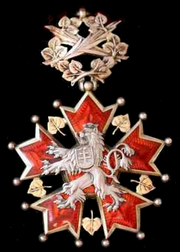
Order of the White Lion of Friedland
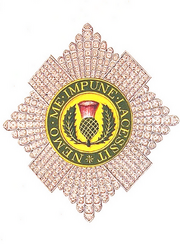
The Most Ancient Order of the Thistle of Pictland
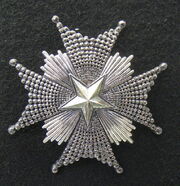
Order of the Pole Star of Kalmar
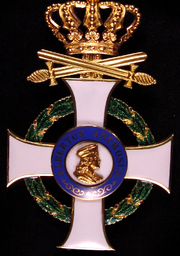
The Albrecht Order of Saxony
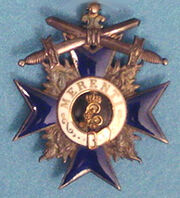
The Ancient Military Order of Franken
| No. | Noble District | Administrative Districts |
|---|---|---|
| 1 | Scotland | Lower Borders, Strathclyde, Upper Borders, Lothian, Stirlingshire, Fife |
| 2 | Pictland | Highlands, Outer Hebrides, Orkney, Zetland, Tayside, Aberdeen |
| 3 | Brandenburg | Vorpommern, Hinterpommern, Brandenburg, Berlin, Stralsund |
| 4 | Sachsen | Nordsachsen, Thüringen, Altsachsen, Nordschliesen, Leipzig, Dresden |
| 5 | Sudetenland | Sudetenland |
| 6 | Franken | Pfalzmark, Franken, Bayreuth |
| 7 | Kalmar-Öland | Kalmar-Öland |
The decorations from these various Noble Districts are traditionally derived, so geographic concepts like the Sudetenland are replaced with historical noble designations.
The oldest of the honours is that of the area of Friedland by Albrecht Wallenstein, whose nephew inherited it after his death in 1638 of heart failure. The Order of the White Lion is distributed to all soldiers originating in the Sudetenland for outstanding service and risks going above and beyond the call of duty. It has four classes, distributed based on the service rendered, length of active service, and number of times decorated in the past. This is the standard for all major noble awards.
After the Order of the White Lion, commissioned in 1623, the next oldest order is that of the Most Ancient Order of the Thistle, founded by Ulrich II just before his death in 1687. Originally a national award, with the fall of the Kingdom, the Order of the Thistle was granted to Pictland, or Highland Scotland, alone. It's brother order, the Order of the Golden Lion, created in 1762 as a civil order, is designated for Lowland Scotland. This Order is younger, however, than the German Order created in Brandenburg by Jörg I, the Order of the Black Eagle, created in 1701. These are the only orders commissioned before 1800. The Napoleonic wars saw a number of Orders rise, especially in Niflungan German lands as part of King Johann I's efforts to appeal to the German people. He created two in 1851, one for the Saxons called the Albrecht Order, named for Albrecht von Wettin-Nibelung (Albert the Bold), who was Duke of Saxony from 1443 until 1500. It was his brother, Heinrich August von Nibelung, who would begin the merging of the two branches of the Nibelungen family. The other Johann created was the Military Merit Order of St. Kilian, Apostle of Franconia, which has since become simply the Ancient Military Order of Franconia. The youngest medal was created in 1869 on the eve of German unification as a nod both to the ORW and the Swedes in Kalmar, the Order of the Pole Star, conferred for especial loyalty shown to the crown. All seven are seen below.
In addition to these higher Orders bestowed for especial service, there are also Meritous medals unique to each of the seven Noble Districts, given to ordinary soldiers who have not achieved any form of nobility. Perhaps the oldest and most famous of these is Brandenburg's Iron Cross of Nibelung, created in 1817 to rival a similar Prussian decoration that would become the first decoration for enlisted men. Others were created over the years, including the Distinguished Service Medal of Scotland (1839), the Sun Cross of Honour of Scotland, now of Pictland (1844), the Medal of Sacrifice of Kalmar (1871), the Waldstein Cross of Friedland (1888), the Luther Rose Medal for Valour of Saxony (1890), and the King Johann II Medal, now the Hammer of Thor Medal for Leadership of Franconia (1915).
National Awards[]
The Noble awards are unique to their specific noble district, but there are higher orders bestowed on individuals regardless of their origin or regiment. The two highest orders in the Commonwealth of Niflunga, the first commissioned by Sigurð Angatýrsson shortly after his rise to power and the second upon his death by the present Vísir.
To be completed...

